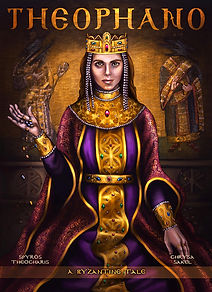



The story of a common girl who managed to become one of the most powerful women of the 10th century medieval Europe.
The main characters of the graphic novel



Nicephorus Phocas
The Domestic of the Scholae
(commander-in-chief of the Roman army)
Krateros
A Tavern owner
(father of Anastasia)
John Tzimiskes
Roman General
(Nephew of Nicephorus Phocas)


JOSEPH BRINGAS
The Praepositus of the Palace
(a eunuch)

BASIL LEKAPENOS
The Imperial Chamberlain
(Brother of Helena Lekapene)
Anastasia/Theophano



ROMANOS
(The Heir to the Throne
Son of Helena and Constantine)
HELENA LEKAPENE
(The Augusta (Empress))
CONSTANTINE PORPHYROGENITUS
(The Emperor (Basileus) of the
Romans. Born in the purple)
WELCOME TO THE 10TH CENTURY ROMAN Empire
ROME FELL IN 476 A.D
BUT THE ROMAN EMPIRE SURVIVED IN THE EAST
THE ROMAN EMPERORS RESIDE IN CONSTANTINOPLE
THE CITY WHICH WAS CHOSEN TO BECOME THE NEW ROMAN CAPITAL
CONSTANTINOPLE
The capital city and administrative center of the Eastern Empire was founded as a New Rome by the Emperor Constantine I. Much of the initial plan of the city was based on that of Rome. A central avenue was created in order to connect each marketplace (forums/fora). This avenue was called Messe. It began from the Golden gate which was the ceremonial gate of the Theodosian walls.
After military victories, the emperors organized triumphs beginning from the Golden gate and ending at the Augustaion, the great public square where Hagia Sophia and the Bronze gate of the palace were located. In addition to that, Constantine built a gigantic hippodrome next to the imperial palace, similar to the Circus Maximus in Rome.
By the 10th century, the city had withstood many sieges by formidable enemies such as the Huns, the Avars, the Bolghars, and the Arabs. The unique triple line Theodosian walls and the geographic location of the City were the most crucial factors for this feat. The city was surrounded by sea from three sides, and the addition of the Theodosian land walls made it almost impregnable. The existence of numerous underground cisterns meant that it could contain enough water reserves to sustain its big population in times of need.


THE ARMY
The rise of the Arab Empire in the 7th century rendered the Roman state from a Mediterranean superpower to a regional power struggling to avoid annihilation by the Arab giant. The Romans lost all their rich eastern provinces like Egypt and Syria. Up until the mid 10th century, the Eastern front had been a one-sided zone of warfare. The Arabs were on the offensive and the Romans defended Anatolia. However, the rise of some great generals such as John Kourkouas and Bardas Phocas the elder turned the tide and brought the empire again on the doorstep of Cilicia and Syria.
In the west, things didn't go so well for the Romans either. Sicily and Crete were lost. These islands served as bases for pirate raids that disrupted trade and devastated the coastal settlements of the Eastern Mediterranean. With the exception of the south, the rest of the Balkan peninsula was dominated by the Bulgarian Empire. On top of that, a new enemy had emerged in the north. The descendants of Vikings, the Rus, had already tried to breach the walls of Constantinople twice.
The Roman army organization is based on the Theme system. Citizens serve as soldiers of the Empire and are rewarded with land. They form the thematic armies under a general who is also the governor of the region. Apart from the themes, the emperor has also got a standing professional army named Tagmata. They are elite forces of the Empire, well trained and equipped with the best available armor and weapons!


THE PALACE
Fountains with perfumed water, elegant gardens, golden mosaics, Mechanical birds, unique Christian relics, and golden thrones. These are some of the most impressive features of the Imperial Palace of Constantinople. The Imperial headquarters combined glamour and mystery which expressed the idea of the Imperial divine right.
Based on this divine right, any Roman citizen could become an emperor as long as they were "favored" by God. Throughout the history of the Empire, there had been several emperors of humble descent.
Numerous Palace officials surround the Imperial family. Most of them are eunuchs who don’t pose a danger to the crown. The palace guards are mostly mercenaries from other countries in order to ensure their loyalty to the emperor.
All the palace ceremonies are carried out according to the palace etiquette. Each ceremony involves different choreography and different outfitting by its participants. There is no single crown that symbolizes the rule of the Emperor. There are many crowns that he can wear according to the occasion.


THE PEOPLE
The majority of the inhabitants of the Empire speak Medieval Greek and adhere to the Constantinopolitan church doctrine. These are the two main pillars of the medieval Roman identity. Unless someone possessed any of these two, they couldn’t call themselves a Roman. Apart from the Romans, there were many groups dwelling within the territory of the Empire. Arabs and Armenians in Anatolia, Slavs and Bulgarians in the Balkans, Lombards, Dalmatians, and other Latin speaking ethnic groups in Southern Italy and the Adriatic coast.









